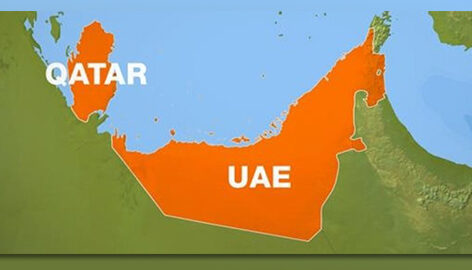

The Gulf Emirate States are an amazing and rich area of the world, with the history of this region stretching back thousands of years. Prior to the discovery of oil there and the wealth from it, what today is the United Arab Emirates and Qatar were a bunch of independent Emirate States under an informal British protectorate, including a foreign monetary system. Due to changes made by other countries that controlled their currency, Dubai and Qatar for a short seven years issued their own joint coinage and currency system. The Joint Coinage of Dubai and Qatar are one of the most sought after collectables.
Under the British-ruled Trucial States, the area of the Gulf States–which included states that would later form the United Arab Emirates, Kuwait, Oman, Bahrain, and Qatar–the British formed a monetary policy. Before the Joint Coinage of Dubai and Qatar came into existence, the British placed these states under the Indian rupee currency.
With Indian independence, the rupee continued to serve as the currency of the Gulf States. Traders in gold would take their precious metal to India to sell it for Indian rupees, then take the Indian currency and trade it for more valuable foreign currency – which they would use to buy more gold. This arbitrage became so great that foreign currency reserves in India were strained. As a result, the Indian government created and printed “Gulf Rupees”, a currency on par with the Indian rupee but for exclusive circulation outside the country. On 6th June 1966, the Indian government devalued the Gulf rupee against the Indian rupee.
The Gulf rupee was the official currency used in the British protectorates of the Arabian Peninsula that are around the Persian Gulf between 1959 and 1966. It was issued by the Government of India and the Reserve Bank of India and was equivalent to the Indian rupee. Notes were issued in denominations of 1 rupee by the Indian government and 5, 10 and 100 rupees by the Reserve Bank of India. The notes were in designs very similar to the standard Indian notes but were printed in different colours. While the 1 rupee and 10 rupee notes were printed in red, the 5 rupee notes were printed in orange and the 100 rupee notes were printed in green. The serial numbers of the banknotes issued in all denominations were prefixed by a Z.
With the creation of the Gulf rupee, some Gulf States foresaw the future economic issue and switched to a different country’s currency. Kuwait and Bahrain issued their own independent dinars pegged to the Indian rupee and thus pegged to the pound. Qatar switched to the Saudi riyal in 1959. But in 1966, Qatar and Dubai came together to form their own single currency, and on March 21, the Qatar-Dubai Currency Agreement was signed by both countries. Hence, the Joint Coinage of Dubai and Qatar came into existence.
Under the Qatar Dubai currency, coins were issued in the denominations of One, Five, 10, 25, and 50 dirhams. The coins feature a sand gazelle on the obverse with the date in both lunar Hijri and Common Era dating systems in Arabic with “Qatar and Dubai” in Arabic below. The reverse features the denomination in Arabic and “Qatar and Dubai” in English. The One and 50 Dirhams were issued only in AH1386-1966; the Five and 25 dirhams were issued in both AH1386-1966 and AH1389-1969, and the 10 Dirhams were issued in AH1386-1966 and in AH1391-1971. The One, Five, and 10 Dirhams were issued in bronze and the 25 and 50 Dirhams were issued in copper-nickel.
The coins circulated along with the currency until 1973. The series is easily collectable, with the exception of the AH1391-1971 10 Dirhams, which has a low mintage of only 1,500 struck by the British Royal Mint and can exceed 1,000 USD in Uncirculated condition in the right auction settings. Joint Coinage of Dubai is one of the fascinating examples among the World Coins!
Joint Coinage of Dubai and Qatar were discontinued from the production when Dubai joined other Emirate states in the formation of the United Arab Emirates. Qatar, which was offered membership, turned it down and continued as its own state, issuing its own independent coinage and currency. The joint coinage and currency of Qatar and Dubai is a historical reminder of the self-sufficiency of the independent Emirates both politically and economically.
The Mintage World Team comprises of experts, researchers and writers from the field of Philately, Notaphily and Numismatics who try to shed light on some of the most interesting aspects of coins, banknotes and stamps from not just India but across the globe as well.